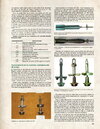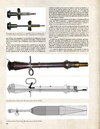Probably the first superquick fuze ever made, The Santiagomundi S fuze series.
The concept of extended probe to cause explosion of bombs over the ground had already been explored and implemented in ww1 - the French with their "Canton-Unne Long", the Russian on with the Gronov fuze, - with a high proportion of duds , thence the number of pictures of bombs equipped with such fuzes stuck in the mud. The Barlow fuze of 1918 was a further more complex exploration of the concept but a dead end as the bomb itself was a failure, having no more effects than the regular Cooper or Michelin bombs.
The Santiagomundi fuze was devised from the start by its inventor, Larauri, as an "extra-sensible" fuze to overcome this shortcoming. It was equipped 's probe extended after release (that freed the safety) and could be installed on various bombs used by the Nationalist in the Spanish Civil war - most commonly the S-1 was used on the German SC-10 10kg bomb and the Spanish Hispania A-5 12kg bomb. However if the vertical suspension system insured a safe release and activation of this fuze, the same was not true when the bomb was suspended horizontally. The operational trials of a Spanish copy of the SC250 bomb, with a nose pocket for such a fuze, ended when the extra-sensitivity of this fuze became evident . The accident that killed Ramon Franco (the brother of, and a noted aviator of the interwar period) was probably due to the premature explosion of such a bomb in the bay of the Cant Z506 he piloted.
The S-1 fuze was the only to enter in serial production but was a neat success - much cheaper than the German fuze, more efficient, it remains in production and use with the Spanish air force till the early sixties ( probably when the CASA produced He111 where phased out of active service).




The concept of extended probe to cause explosion of bombs over the ground had already been explored and implemented in ww1 - the French with their "Canton-Unne Long", the Russian on with the Gronov fuze, - with a high proportion of duds , thence the number of pictures of bombs equipped with such fuzes stuck in the mud. The Barlow fuze of 1918 was a further more complex exploration of the concept but a dead end as the bomb itself was a failure, having no more effects than the regular Cooper or Michelin bombs.
The Santiagomundi fuze was devised from the start by its inventor, Larauri, as an "extra-sensible" fuze to overcome this shortcoming. It was equipped 's probe extended after release (that freed the safety) and could be installed on various bombs used by the Nationalist in the Spanish Civil war - most commonly the S-1 was used on the German SC-10 10kg bomb and the Spanish Hispania A-5 12kg bomb. However if the vertical suspension system insured a safe release and activation of this fuze, the same was not true when the bomb was suspended horizontally. The operational trials of a Spanish copy of the SC250 bomb, with a nose pocket for such a fuze, ended when the extra-sensitivity of this fuze became evident . The accident that killed Ramon Franco (the brother of, and a noted aviator of the interwar period) was probably due to the premature explosion of such a bomb in the bay of the Cant Z506 he piloted.
The S-1 fuze was the only to enter in serial production but was a neat success - much cheaper than the German fuze, more efficient, it remains in production and use with the Spanish air force till the early sixties ( probably when the CASA produced He111 where phased out of active service).






